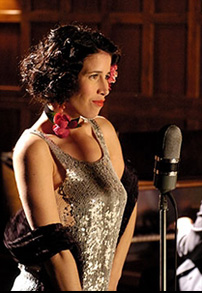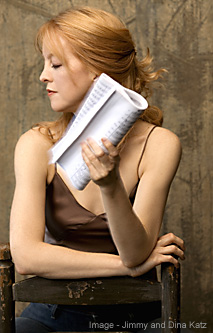|
The Velvet Devil
Andrea Menard, performer, playwright, and song writer, arrived in Peterborough, Ontario, like a hitchhiker with a bundle of hosannas about her work. Starting out at the Saskatchewan Native Theatre Company in Saskatoon, "The Velvet Devil " is a one woman show touring Canada. The play highlights the career of the torch singer, Velvet Laurent. In the early 1940's Laurent hid her Métis heritage to make her way into the singing circuit. Who can blame her for trying to slip under the door in disguise, and make a name for herself, and a living? Escaping the poverty of, and the racism towards indigenous peoples in Canada, had its price. The loss of roots always does, whether it be the melting pot, or the hosannas of show biz, the Velvet Laurent tale of longing and remorse, a complex palate of talent, self denial, love, guilt, resentment, and courage to go on, was amplified by Andre Menard's powerful, yet lyrical voice, used to full advantage.
The Market Hall auditorium in Peterborough, Ontario, aptly transformed into a night club environment, provided an intimate sounding board for Menard.  Menard's emotionally charged voice, clear and higher in intensity than, say, Billie Holiday's painfully slung seductive one, fills to the brim with a sense of crisis. Singing the Velvet Devil's tale with revealing asides, the story highlights Velvet Laurent's painful break with her mother, her journey into the pits of low level show biz, with all its rankling pettiness and self deceptive absorption; her haywire relations with men going from bad to worse to a little better; and finally the death of her mother, never having seen her again, wrenching the singer to the core. All of which, in the hands of a lesser talent, can easily become show biz cliché. The link here, though, is the grappling hook in this music drama. Trial and error resonates throughout Laurent's struggle to escape her past and rise above tribal bonds. Staying the course becomes prehensile, identifiable, and ultimately disenchanting. The drama lies in when the going gets tough, the tough gets going. Menard's emotionally charged voice, clear and higher in intensity than, say, Billie Holiday's painfully slung seductive one, fills to the brim with a sense of crisis. Singing the Velvet Devil's tale with revealing asides, the story highlights Velvet Laurent's painful break with her mother, her journey into the pits of low level show biz, with all its rankling pettiness and self deceptive absorption; her haywire relations with men going from bad to worse to a little better; and finally the death of her mother, never having seen her again, wrenching the singer to the core. All of which, in the hands of a lesser talent, can easily become show biz cliché. The link here, though, is the grappling hook in this music drama. Trial and error resonates throughout Laurent's struggle to escape her past and rise above tribal bonds. Staying the course becomes prehensile, identifiable, and ultimately disenchanting. The drama lies in when the going gets tough, the tough gets going.
The Velvet Devil 3 piece band playing of Teegan Jeffers on bass, Alan Long on drums, and Nate Reinne, guitarist and band leader, backed her with upbeat bluegrass riffs, tinged with blues, jazz, a touch of gospel, and often lively humor. What I felt was missing was the cloud behind the lining. The distant drumming of her Métis background, the psychological sense of the past defining the present, the dark changing mood of lost horizons, all of which music is capable of doing when it captures the heart in its hands. Although Andrea Menard's penetrating singing clearly took care of itself, her acting needed to be tested – to make her approach complete. All together though, an embracing achievement, freshly done.
The Resonant Baton
The first thing I noticed about Maria Schneider conducting her Jazz Orchestra at the Eastman Theatre in Rochester, New York is how she listens to her orchestra. Watching her conduct is like witnessing intricate dance calligraphy, with a baton. Well timed, dramatic, consumed by the flow and resonance of music, standing still, silent, rapt, Schneider is like a traffic cop on a four way street. Keen observation and listening is the key to her success. She knows how to leave enough alone when the music is formatting itself. Which may, in the long run, be an essence of fine conducting.
Schenider has an accomplished career, as a conductor and composer.  She has earned Grammy awards, national and international commissions, stints in Europe, South America and across the U.S., including a composition for the Philobulous dance company. To mark time accurately, her conducting appearance was old home night. A graduate of the Eastman School of Music, Schneider's Jazz Orchestra waved flags all the way around, with a flourish. The Eastman Theater is one of the most hospitable concert halls I have ever been to: a perfect sounding board of a warm atmosphere for conducive listening. She has earned Grammy awards, national and international commissions, stints in Europe, South America and across the U.S., including a composition for the Philobulous dance company. To mark time accurately, her conducting appearance was old home night. A graduate of the Eastman School of Music, Schneider's Jazz Orchestra waved flags all the way around, with a flourish. The Eastman Theater is one of the most hospitable concert halls I have ever been to: a perfect sounding board of a warm atmosphere for conducive listening.
Schneider and her band offered music of bracing clarity, fine arrangements, and jazz conversations of subtlety and energy. "Concert in the Garden" was the first number. Gary Versace on accordion and Frank Kimbrough on piano, the two instruments happily intriguing with their lively interplay of mystery and swing. When fifteen musicians followed, hoisting the flag - reeds, trombones, trumpets, guitar, drums, and bass - target practice commenced with a big band blast without deafening the ears.
South American influences dominated "Aires de Lando"; haunting, fluid, and exploratory. Scott Robinson uplifted the aficionado work with his buoyant clarinet swinging over the top of brass and reeds. The Peruvian thematic spin was well counterpointed with lively hand clapping. "El Vento" had a primordial sound, blending jazz riffs, especially Marshall Giles on trombone, Ben Monder's erstwhile guitar, and the trumpet brigade of Tony Kadlec, Greg Gisbert, Laurie Frink, and Ingrid Jensenm, lifting the music with bold swinging - done within a tight, classical structure.
"Green Peace" opened the second act, with exceptional timing, like a well paced film. Schneider led the orchestra with intricate dance calligraphy along with her baton. Stepping in and about, sometimes silent and still, Schneider has the grace to let the orchestra lead her, and then wheels in to format the group for emphasis. Conducting a full scale jazz orchestra is an art that emphasizes keen musicianship. When it's done with full absorption its adds zest and fortitude to the occasion. Schneider blends the music with subtlety engrossed impact.
The second act was a luxury, topping the first. "Green Peace" opening melodiously, with Frank Kimbrough on piano, ably assisted with the flawless trumpet playing of Laurie Fink, or was it Ingrid Jenson? I never got that straight, they were both equally triumphant in their playing. That well channeled riff was followed by "Riche's Piece", suggesting a theme by Aaron Copland. The music was highlighted by the lovely reed playing of Rich Perry embracing subtle references with neat swing. "Cerulean Skies" completed the circle of enchantment. A full scale composition, lifting like a flock of birds circling Central Park, Seamus Black and Charles Pillow lead the talented musicians into a final landing with flair and finesse. Altogether a refreshing promenade of top flight playing and bright, triumphant big band jazz. A knock out evening of jazz; a talented centipede of musicians scaling the runs, led by a conductor who tracks the offering like an Olympic coach. Definitely here, there and everywhere, but also always keenly on top of the changes. That kind of energy in mid winter melts the frost away.
|
|

